There’s a new sheriff in town
Neighbors on Duane and Jay have taken rat matters into their own hands and have installed new fangled rat traps that catch critters by the dozen. And it works well enough that even the mayor-elect is touting them. B. first spotted the one on Staple (above); I got in touch with 55 Hudson and by then the Friends of Duane Park had ordered two for their burrow.
So, these are not your average rat traps. The 2-foot-high boxes have a ladder up the front that the rats use to get to the top floor and find the food that’s waiting. Then a hair trigger in the back sends them flying down a trap door into a solution that knocks them out instantly (the formula is protected, but it’s an alcohol base that kills them a short while later). The devices are made by a company in Italy and are high tech: they are electric and controlled remotely, so you know how many you’ve got in there (and know when to empty it). There’s a counter on the outside that also keeps track.
“My record was 46 rats in a week and a half in a pharmacy in Williamsburg,” said Pat Marino who owns Rat Trap Distribution and has installed the ones in Tribeca. He started working with Eric Adams in 2019, and soon after secured the rights to distribute them here. He also perfected the solution, which has made them much more successful.
He also has worked on his technique. For instance, he “primes” the trap at first — he leaves it in place but not turned on, so the trap door doesn’t work — and allows the rat colony to get used to it as a safe food source — one rat follows the other’s scent. And after a couple weeks of that he turns it on. Each trap holds up to 40 rats, who check in… you know the rest. Plus they never return to the nest to warn the others AND the solution hides the scent of death, another good warning sign to stay away.
“They are incredible creatures of survival to be honest,” Marino says.
Marino works with National Geographic study data that estimates that two rats produce up to 15,000 offspring in one year. It’s gruesome to watch but the math works like this: each mother rat can have 12 babies; she can have a litter a month, so that’s 144 per year. The babies can have babies within two months, and those babies can have babies two months after and so on so the number for that first couple gets to 15K.
Taking breeders off line is part of what slows down the population — and while he says he has been able to eliminate some colonies altogether, the goal is to get things under control. If you are seeing them during the day, that’s when you know you’ve got trouble.
I was hoping Marino would know why we have so many and he points to the closing of the restaurants during the pandemic: until then, most of the rats relied on public spaces as a food source. Once that was gone, they moved in on the private residence garbage. It doesn’t help that a lot of buildings put their garbage out the night before trash pickup. That’s dinner time.
He says it takes about a year to reduce a colony, and then you can leave a smaller number of traps in place to maintain the population. His staff does all the trap maintenance, including removing the rats — Friends of Duane Park is paying $250 per box per month to deal with what they say is a totally new infestation.
“For years we have had two burrows and everything has stayed pretty much contained with no growth,” said Karie Davidson, president of the Duane Park board. “But starting in July it got completely out of control. It’s just beyond. The hole at the western side is probably 6 inches wide. Usually our holes are closer to mouse-sized. Now it’s like a terrier could fit through there.”
If only we had a terrier problem…







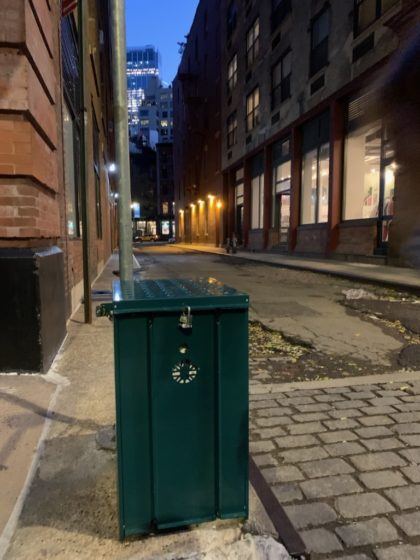
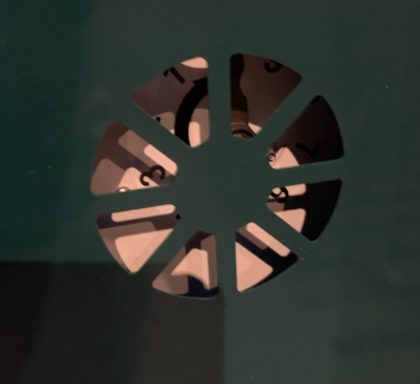
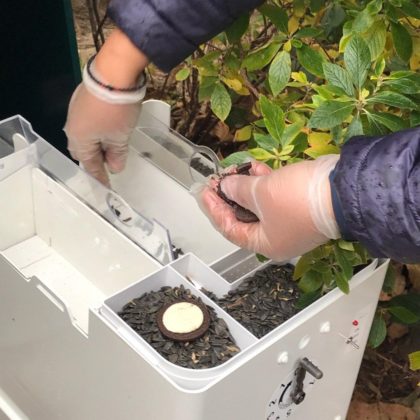
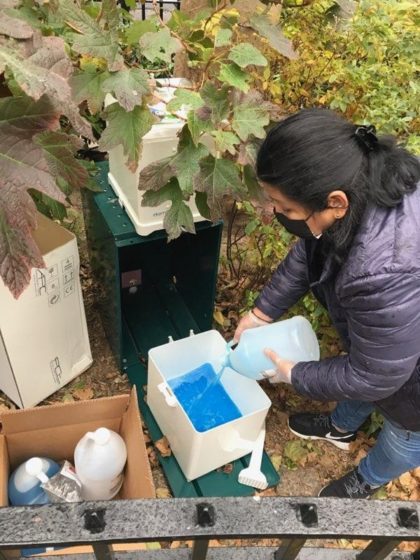
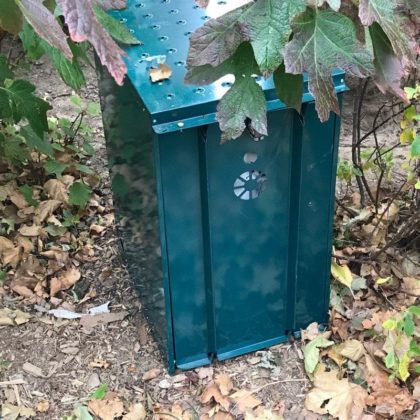








What a brilliant idea
put them all over this neighborhood and beyond. Looks like a great idea
i’m out in the wee hours a lot and i had noticed that the rat activity in front of washington market park has diminished over the past few weeks. i know it needs to be done but i feel sorry for them.
“I was hoping Marino would know why we have so many and he points to the closing of the restaurants during the pandemic: until then, most of the rats relied on public spaces as a food source.”
actually, i think it’s the outdoor eating shacks that are the problem. i see rats constantly scurrying the short distance between the shacks and the garbage bags. virtually every shack has rat nests hidden underneath.
I’m sure the pigeon lady who’s constantly feeding the flocks in Duane Park isn’t helping, given I’m sure whatever the birds don’t eat is food for the rats.
I am sure the pigeon lady means well but her activity of feeding birds extra than what they’re getting in the streets is not OK. Their poop covers the windows all around in such gross quantities. I wish she would stop.
Also, Sarabeth’s careless trash is such a culprit there on Jay- they are so irresponsible. I walk past most mornings and it’s a different food scrap in an enormous quantity- 30 avocado halves, dozens of egg shells- all thrown on the sidewalk bc the rats chew through their plastic bags and everything pours out. disgusting.
What an unkind comment. A woman who cares about the welfare of living creatures is reduced to “the pigeon lady”.
decades ago, families would have Pigeon Copes on the roof and they would feed them and take care of them even train them to come back. we still feed pigeons here in Tribeca.
Thank god and we need more. I just had to spend $3k+ to repair all the damage they did to the wiring in my car after only being stationary for a week. I would have to imagine it has happened to a lot of people in the neighborhood.
After 3 days in front of 11 Jay our car wires were shot. Who knew the plastic coating on the wiring contains soy! We are still waiting for the damage report.
Absolutely agree that the sheds are the main problem. This is a fantastic idea and hope they are put up over the entire neighborhood. As a matter of fact why don’t the restaurants with sheds pay the monthly expenses for the traps? The bigger your takeover of the street, the higher your monthly maintenance.
At first, I thought it was a great idea to make the restaurants pay for rat mitigation. But, on second thought, they continue to fight to survive themselves, and another added cost of doing business in NYC would likely drive some more away. We need and want a vibrant restaurant scene in Tribeca.
Let’s remember that Friends of Duane Park is a volunteer organization improving our neighborhood via donations. As someone who has seen way too many rats on the local streets and sidewalks, I am so grateful that they are trying to address the problem. I suggest that we should all remember what they do and make a donation to support them if able. For the record, I have no affiliation with them, just grateful for their efforts.
What an excellent idea!!! The city needs to move on this immediately!’ Not only Manhattan but all the boroughs!
This seems very cruel. Is there a more humane way to control the urban rat population than killing them?
FDP looked into sterilization but it’s not practical. In order to work, the medication would have to be consumed daily for a prolonged period of time. Ideas welcome: info@duanepark.org
A note on pigeons: their caregiver is a neighbor and a friend; our experience is there is no food left behind.
Could Oreo Cookies Solve New York’s Rat Problem?
https://www.nytimes.com/2021/12/17/nyregion/rat-traps-nyc.html?referringSource=articleShare
FYI the pigeons never leave any food on the ground. Just the opposite. They clean up whatever food people drop, making it harder for the rats to find food.
The 2 scavenger species tend to compete for food. Usually one or the other will dominate on a block, making it hard for the other to gain a foothold. I’d think the birds were why the rat population was kept stable at only 2 burrows until all the restaurant sheds popped up all over the area with people dropping bits of food here and there. Then the rats had enough food to be able to multiply.
Will it be posted somewhere how many rats the units at the different locations catch? Area residents should be able to find out whether their numbers are decreasing.
lt would be good to know whether any other animals are trapped, especially squirrels. Prior to some major rat elimination campaigns a couple of decades ago there used to be a lot more squirrels around, including in Duane Park. Now it is a rarity to see them.
If the solution the rats fall into truly does instantly render them unconscious then it is kinder than most rat poisons, which cause prolonged suffered up until death. I hope that claim was verified before the units were installed.
I doubt anyone will post their numbers — these are mostly private efforts.